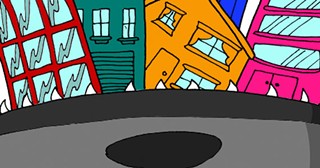Halifax is known for its recycling. In the world of wasters, we're among the best at cleaning up after ourselves. We don't bury all our old toys underground anymore. Half our junk is diverted through composting, recycling and shipping it to the Chinese countryside.
Our municipality also has one of one of the highest recycling rates of construction and demolition waste in the country. Companies bring their C&D waste to one of three depots, which are legally required to recycle at least 75 percent of it.
The problem is, like our run-of-the-factory plastic waste, no one knows what that means. "It goes to all privately run recyclers and who we send it to always changes," explains Shari Dillman, who works in C&D at HRM.
Dillman is uncertain how the material is used after that, but a "small amount does get landfilled." When a building is demolished ---flattened without any attempt to sort the materials---things like gyprock become useless. While usable metal is pulled out of the rubble, plastic and vinyl are ground into landfill cover, which is considered recycling.
Thom Oommen co-wrote a guide to ecological C&D for the Ecology Action Centre called Waste? Not! He says that, post-demolition, some materials are too contaminated to recycle, though they could be re-used by a do-it-yourselfer. "If wood is treated or painted it's landfilled."
Much of the usable wood is chipped up and burned for energy. It beats landfilling but burning a perfect building material can't be called green.
According to EAC's guide, "Asphalt shingles, clean wood, drywall, metal, painted and composite wood, plastics, aggregates, drywall and treated wood are estimated to make up 25 to 30 percent of all solid waste in Nova Scotia. This translates to between 175,000 and 200,000 tonnes in the province annually."
Much of that waste could be avoided if companies practiced deconstruction---the methodical taking apart of old buildings and sorting the materials. But, "you can demolish or deconstruct any way you wish," Dillman says. "There are no rules on that."
There are, however, incentives, in the form of reduced tipping fees---charged by weight at the C&D depots---for companies that pre-sort their waste. "But demolishers usually have the upper hand," says Einer Christensen, an engineer with Solterre Design, a Halifax firm specializing in green design. That's because the lowest bidder almost always gets the take-down contract, and demolition is quicker, cheaper and easier than proper deconstruction, despite the higher tipping fees.
"It's all reusable and recyclable but, with the cost of labour to remove plaster and nails, it's not profitable," adds Jennifer Corson, an architect at Solterre and owner of Renovator's Resource, a store selling used building materials.
Yet, contractors and do-it-yourselfers' demand for loved-again materials has kept Corson's store going for 17 years. They come to save money and energy and find unique items that stand out from the made-in-China mainstream.
Corson argues that a major cultural shift is needed in the construction industry. "It's the disposable era," she says---a time when products, even buildings, aren't designed to last. "Conservation hasn't been the norm since World War II. Buildings from the '80s are hard to recycle; there's just not a lot of quality material in them."
Oommen calls it a "culture of demolition: demolish and rebuild." Little thought is given to embodied energy---the energy invested in creating a building, which is wasted and spent again when a building is replaced rather than renovated. That waste is what architect Carl Elefante was getting at when he said, "The greenest building is the one already built."
The good news is that Corson, Christensen and Oommen have all seen progress in the industry driven by the rising costs of material and disposal. Corson loves EAC's Waste! Not? guide and says it's a small example of the kind of education the industry needs.
Oommen adds that HRM could extend its regulatory teeth further on this issue. "If when you applied for a demolition permit you were required by law to sort the waste it would really encourage re-use," he says.
Chris Benjamin is author of the novel Drive-by Saviours.













